You searched for: 河南福彩22选5走势图大星彩【杏彩体育qee9.com】6OjqT
<< Previous | Displaying results 151-200 of 423 for "河南福彩22选5走势图大星彩【杏彩体育qee9.com】6OjqT" | Next >>
-

-
Police maintain watch outside the Eldorado nightclub, long frequented by Berlin's gay and lesbian community.
PhotoPolicemen stand outside the shuttered Eldorado nightclub, long frequented by Berlin's gay and lesbian community. The Nazi government quickly closed the establishment down and pasted pro-Nazi election posters on the building. Berlin, Germany, March 5, 1933. Learn more about this photograph.

-
The 26th Infantry Division during World War II
ArticleThe 26th Infantry Division participated in major WWII campaigns and is recognized for liberating the Gusen subcamp of Mauthausen in 1945.
-
Herzogenbusch Main Camp (Vught)
ArticleThe Herzogenbusch concentration camp in the Netherlands began functioning in January 1943. Learn about its establishment, administration, prisoners, and conditions there.

-
The Holocaust in Macedonia: Deportation of Monastir Jewry
ArticleIn March 1943, Bulgarian authorities transported the entire Jewish community of Monastir to a transit camp from which they were deported to Treblinka.

-
Mannschafts-Stammlager (Stalag) IX B
ArticleIn 1939, the Nazis established the Mannschafts-Stammlager (Stalag) IX B camp in Germany. Learn more about the camp’s history, prisoners, and liberation.
-
Gisha Galina Bursztyn: Maps
Media EssayBorn to Jewish parents in Poland, Gisha Galina Bursztyn moved to the city of Warsaw after she married. On September 1, 1939, Germany invaded Poland. Warsaw fell four weeks later, and a ghetto was set up in November 1940. During a massive roundup i...
-
Receipt for items confiscated from Moshe Zupnik
DocumentSoviet authorities issued this receipt, in Russian, to Moshe Zupnik for the rubles they confiscated from him before he left the Soviet Union. Soviet authorities routinely confiscated most rubles and other valuables from Jewish refugees before they boarded steamers bound for Japan and left the Soviet Union. Vladivostok, Soviet Union, January 22, 1941. [From the USHMM special exhibition Flight and Rescue.]
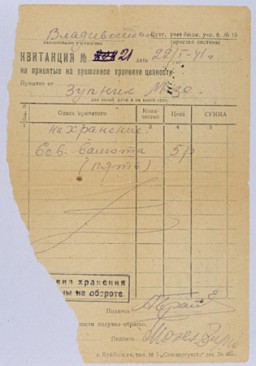
-
Pogrom in Lvov
FilmThe Soviet Union occupied Lvov in September 1939, according to secret provisions of the German-Soviet Pact. Germany invaded the Soviet Union on June 22, 1941, occupying Lvov within a week. The Germans claimed that the city's Jewish population had supported the Soviets. Ukrainian mobs went on a rampage against Jews. They stripped and beat Jewish women and men in the streets of Lvov. Ukrainian partisans supported by German authorities killed about 4,000 Jews in Lvov during this pogrom. US forces discovered…

-
A family of Macedonian Jews before deportation
PhotoA family of Macedonian Jews in the Tobacco Monopoly transit camp in Skopje before deportation. Skopje, Yugoslavia, March 1943. The Jews of Bulgarian-occupied Thrace and Macedonia were deported in March 1943. On March 11, 1943, over 7,000 Macedonian Jews from Skopje, Bitola, and Stip were rounded up and assembled at the Tobacco Monopoly in Skopje, whose several buildings had been hastily converted into a transit camp. The Macedonian Jews were kept there between eleven and eighteen days,…
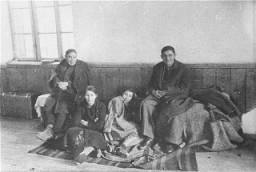
-
Deportation of Jews from Skopje
PhotoDeportation of Jews from Skopje, Yugoslavia, March 1943. The Jews of Bulgarian-occupied Thrace and Macedonia were deported in March 1943. On March 11, 1943, over 7,000 Macedonian Jews from Skopje, Bitola, and Stip were rounded up and assembled at the Tobacco Monopoly in Skopje, whose several buildings had been hastily converted into a transit camp. The Macedonian Jews were kept there between eleven and eighteen days, before being deported by train in three transports between March 22 and 29, to Treblinka.

-
Nazi Persecution of Soviet Prisoners of War
ArticleNazi Germany waged a war of annihilation against the Soviet Union. This included brutally treating Soviet POWs and murdering them on a mass scale. Learn more.
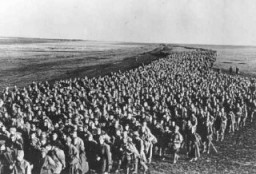
-
German Invasion of Western Europe, May 1940
ArticleGerman troops overran Belgium, the Netherlands, Luxembourg, and France in six weeks starting in May 1940. Anti-Jewish measures soon followed in occupied western Europe.

-
Amsterdam
ArticleLearn about Amsterdam during World War II and the Holocaust, including deportations of Jews to concentration camps and killing centers.
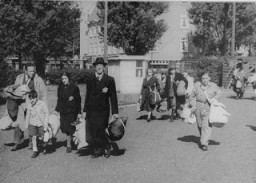
-
Danzig
ArticleHitler was determined to overturn the military and territorial provisions of the Versailles treaty, among it was much resented loss of the city of Danzig after WWI.

-
Norway
ArticleGermany invaded Norway on April 9, 1940. Read more about this invasion, the collaborator Vidkun Quisling, and the tragic fate of Norway’s Jews.
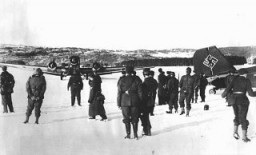
-
Sachsenhausen: Key Dates
ArticleKey dates in the history of the Sachsenhausen camp in the Nazi camp system, from its establishment in 1936 to the postwar trial of camp staff in 1947.

-
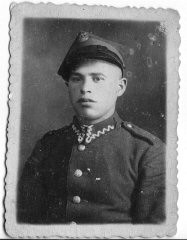
-
Sam Gruber (Jewish Partisan Educational Foundation biography)
ArticleRead the Jewish Partisan Educational Foundation's short biography of Sam Gruber.

-
Janusz Piotrowski
ID CardJanusz was the eldest of four children born to Catholic parents in Plock, a town located in a rural area north of Warsaw. His father was an accountant. Janusz attended local schools, and became active in scouting. 1933-39: Janusz went to Warsaw to study civil engineering. On September 1, 1939, the Germans began bombing Warsaw. One week later, all able-bodied men who had not been mobilized were directed to retreat east. On September 17, Janusz was 90 miles from the Romanian border. That night, the Soviets…

-
Chaje Isakovic Adler
ID CardThe youngest of 11 children, Chaje was raised by religious, Yiddish-speaking Jewish parents in a village in Czechoslovakia's easternmost province. At the age of 12, she was apprenticed to a men's tailor. In the 1920s she married Jermie Adler from Selo-Solotvina. Together, they moved to Liege, Belgium, where they raised three daughters and she continued to work as a tailor. 1933-39: Chaje's customers called her the "Polish tailor." Raising her children as Jews in the largely Catholic city of Liege did not…
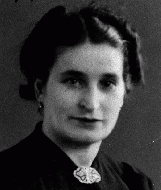
-
Page from Earl G. Harrison's diary entry describing postwar Linz
DocumentPage from Earl G. Harrison's notebook, recording his impressions of Linz, Austria, while on a tour of displaced persons camps in 1945.

-
Hainewalde
ArticleThe SA established a protective custody camp at Hainewalde in March 1933. Well-known journalist and writer Axel Eggebrecht was among its early prisoners.
-
Blechhammer
ArticleThe Germans established the Blechhammer camp as a subcamp of Auschwitz in April 1941. Learn about the camp's history and conditions there.
-
Liberation of Mauthausen
Timeline EventMay 5, 1945. On this date, US troops liberated Mauthausen concentration camp. Days before, a group of prisoners took control of Mauthausen.
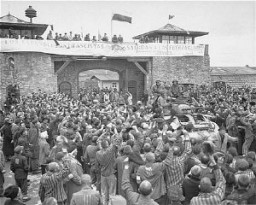
-
Embroidered matzah cover
ArtifactFollowing the Soviet occupation of Lithuania, the Lifszyc family began to search for ways to leave the country. David Lifszyc obtained a Curacao visa from the Dutch consulate. He also obtained an American visa because he was included on a list of distinguished rabbis submitted to the State Department by the Agudat Israel of America. After obtaining Soviet exit visas, the Lifszycs purchased tickets for Vladivostok on February 5, 1941. They started for Moscow, where they received Japanese transit visas. This…
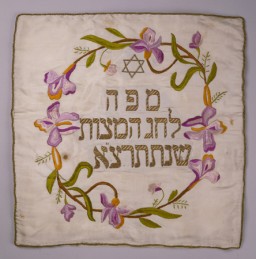
-
European Jewish population distribution, ca. 1933
MapJews have lived in Europe for more than two thousand years. The American Jewish Yearbook placed the total Jewish population of Europe at about 9.5 million in 1933. This number represented more than 60 percent of the world's Jewish population, which was estimated at 15.3 million. Most European Jews resided in eastern Europe, with about 5 1/2 million Jews living in Poland and the Soviet Union. Before the Nazi takeover of power in 1933, Europe had a dynamic and highly developed Jewish culture. In little more…

-
Jakub Lapides
ArticleYoung people's diaries bear witness to some of the most heartbreaking experiences of the Holocaust. Learn about the diary and experiences of Jakub Lapides.
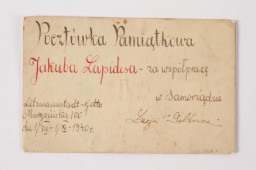
-
Theresienstadt: SS and Police Structure
ArticleLearn more about the unique SS and police structure of the Theresienstadt “camp-ghetto” during World War II.
-
Jewish Population of Europe in 1933: Population Data by Country
ArticleBefore the Nazis seized power in Germany in 1933, Europe had a richly diverse set of Jewish cultures. Learn more about the Jewish population of Europe.

-
The Enabling Act
ArticleThe Enabling Act of March 1933 allowed the Reich government to issue laws without the consent of Germany’s parliament. It laid the foundation for the Nazification of German society.

-
Law for the Imposition and Implementation of the Death Penalty
ArticleLearn more about the Law for the Imposition and Implementation of the Death Penalty, which the Nazis enacted after the Reichstag Fire Decree in 1933.
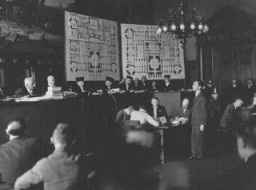
-
Abba Kovner
ArticleRead the Jewish Partisan Educational Foundation's short biography of Abba Kovner.
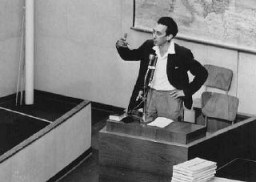
-
The 80th Infantry Division during World War II
ArticleThe 80th Infantry Division participated in major WWII campaigns and is recognized for liberating Buchenwald and the Ebensee subcamp of Mauthausen in 1945.
-
The Bielski Partisans
ArticleUnder the protection of the Bielski partisan group, founded by brothers Tuvia, Asael, and Zus, over 1,200 Jews survived after fleeing into forests in western Belarus.
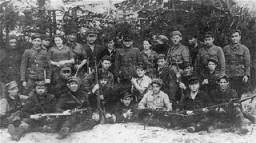
-
World War II in Europe
ArticleGermany started World War II in Europe on September 1, 1939, by invading Poland. War would continue until 1945. Learn more about WWII and genocide in Europe.
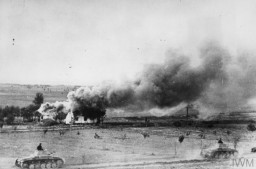
-
Polish Jews in Lithuania: Escape to Japan
ArticleAfter 1940, Polish refugees were pressured to leave Lithuania. Learn more about the diplomats that assisted them and their journey to Japan.
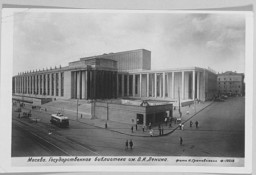
-
Genocide Timeline
ArticleKey dates in the use of the term genocide as part of the political, legal, and ethical vocabulary of responding to widespread threats of violence against groups.

-
Moringen Youth Camp
ArticleThe Moringen camp was one of the so-called youth protection camps that the Nazi regime established for young people who were alleged to have strayed from Nazi norms and ideals.
-
Drancy
ArticleThe Germans established an internment camp at Drancy in August 1941. The following summer, Drancy became the main transit camp for deportations of Jews from France.

-
Soviet Secret Police massacre in Lvov
FilmThe Soviet Union occupied Lvov in September 1939, according to secret provisions of the German-Soviet Pact. Germany invaded the Soviet Union on June 22, 1941. After a week of bitter fighting, German forces occupied Lvov. They discovered that the Soviet Secret Police had massacred thousands of prisoners, mostly Ukrainian nationalists, before fleeing from the city. This footage shows the removal of the bodies of some of those massacred. The Germans claimed that the city's Jewish population had supported the…
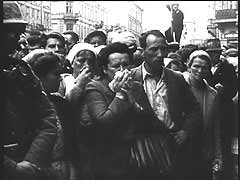
-
Jews from Macedonia before deportation
PhotoJews from Bulgarian-occupied Macedonia who were rounded up and assembled at the Tobacco Monopoly transit camp in Skopje before deportation to the Treblinka killing center. Skopje, Yugoslavia, March 1943. The Jews of Bulgarian-occupied Thrace and Macedonia were deported in March 1943. On March 11, 1943, over 7,000 Macedonian Jews from Skopje, Bitola, and Stip were rounded up and assembled at the Tobacco Monopoly in Skopje, whose several buildings had been hastily converted into a transit camp. The…
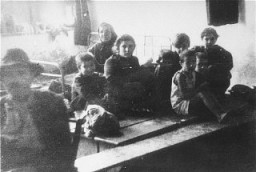
-
Macedonian Jews leave the Tobacco Monopoly transit camp in Skopje for the deportation trains
PhotoMacedonian Jews leave the Tobacco Monopoly transit camp in Skopje for the deportation trains. Skopje, Yugoslavia, March 1943. The Jews of Bulgarian-occupied Thrace and Macedonia were deported in March 1943. On March 11, 1943, over 7,000 Macedonian Jews from Skopje, Bitola, and Stip were rounded up and assembled at the Tobacco Monopoly in Skopje, whose several buildings had been hastily converted into a transit camp. The Macedonian Jews were kept there between eleven and eighteen days, before being…
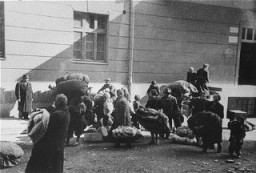
-
Presenting the prosecution's case at the International Military Tribunal
PhotoUS Major Frank B. Wallis (standing center), a member of the trial legal staff, presents the prosecution's case to the International Military Tribunal at Nuremberg. A chart (top left) shows where the defendants (bottom left) fit into the organizational scheme of the Nazi Party. At right are lawyers for the four prosecuting countries. Nuremberg, Germany, November 22, 1945. The trials of leading German officials before the International Military Tribunal are the best known of the postwar war crimes trials.…
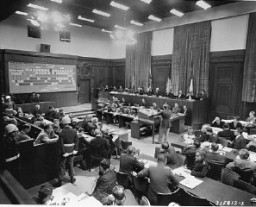
-
Jews from Macedonia before deportation to the Treblinka killing center
PhotoJews from Macedonia who were rounded up and assembled in the Tobacco Monopoly transit camp before deportation to the Treblinka killing center. Skopje, Yugoslavia, March 1943. The Jews of Bulgarian-occupied Thrace and Macedonia were deported in March 1943. On March 11, 1943, over 7,000 Macedonian Jews from Skopje, Bitola, and Stip were rounded up and assembled at the Tobacco Monopoly in Skopje, whose several buildings had been hastily converted into a transit camp. The Macedonian Jews were kept there…

-
Jews outside the Monopol tobacco factory transit camp
PhotoJews outside the Monopol tobacco factory, used as a transit camp by Bulgarian authorities during deportations from Macedonia to the Treblinka killing center in German-occupied Poland. Skopje, Yugoslavia, March 1943. The Jews of Bulgarian-occupied Thrace and Macedonia were deported in March 1943. On March 11, 1943, over 7,000 Macedonian Jews from Skopje, Bitola, and Stip were rounded up and assembled at the Tobacco Monopoly in Skopje, whose several buildings had been hastily converted into a transit camp.…

-
Jews prepare soup outside the Monopol tobacco factory transit camp
PhotoJews prepare soup outside the Monopol tobacco factory, used as a transit camp by Bulgarian authorities during deportations of Jews from Macedonia. Skopje, Yugoslavia, March 1943. The Jews of Bulgarian-occupied Thrace and Macedonia were deported in March 1943. On March 11, 1943, over 7,000 Macedonian Jews from Skopje, Bitola, and Stip were rounded up and assembled at the Tobacco Monopoly in Skopje, whose several buildings had been hastily converted into a transit camp. The Macedonian Jews were kept there…
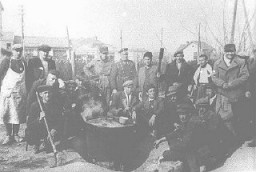
-
Macedonian Jews prepare to board a deportation train in Skopje
PhotoMacedonian Jews prepare to board a deportation train in Skopje. Skopje, Yugoslavia, March 1943. The Jews of Bulgarian-occupied Thrace and Macedonia were deported in March 1943. On March 11, 1943, over 7,000 Macedonian Jews from Skopje, Bitola, and Stip were rounded up and assembled at the Tobacco Monopoly in Skopje, whose several buildings had been hastily converted into a transit camp. The Macedonian Jews were kept there between eleven and eighteen days, before being deported by train in three transports…

-
Debate within the Lokacze Ghetto
ArticleDifficult debates took place within ghettos about whether and how to resist under the most adverse conditions. Read a rare account from the Lokacze ghetto.
